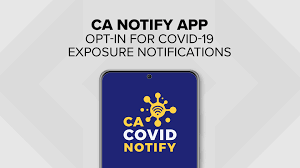 _________________________________
_________________________________


 “In towns and cities... there is no more important institution than the local paper.”
Warren Buffett
“In towns and cities... there is no more important institution than the local paper.”
Warren Buffett

BY BRIAN HEWS• December 10, 2020
Californians now have the option to receive notifications on their smartphone if they’ve been exposed to someone who has tested positive for the novel coronavirus.
Called CA Notify, the app relies on programs created by Apple and Google that use Apple and Android phones’ short-range Bluetooth capability to determine when two devices have been near one another for more than 15 minutes.
Gov. Gavin Newsom said it would be key to supporting California’s contact tracing efforts and comes at a time when coronavirus hospitalizations have surged past 10,000 in California.
“This holds a lot of promise,” Newsom said at a news conference Monday. “The more people that participate in it, the more that opt in, the more effective this program can be.”
But that’s the key, people need to use it.
Once you activate CA Notify, it does all the work. All you do is keep your Bluetooth on. You will only receive alerts if you were in close contact with someone who tests positive for COVID-19. Your privacy is protected as your identity is not known and your location is not tracked.
A user who tests positive for COVID-19 may choose to notify other CA Notify users who have been near the user. To trigger such notification, the COVID-19 positive user must enter a valid verification code provided by the medical provider, lab, or local public health authority.
On iOS devices (version 13.7 or later) the exposure notification system is activated within Settings and no app installation is required. A user goes to Settings, scrolls down to Exposure Notifications, turns on Exposure Notifications, and selects United States then California.
On Android devices an app is available for download.
Dr. Christopher Longhurst at UC San Diego Health said in a statement that the app proved effective in a program in the fall involving an over 250,000 students, staff and faculty at seven UC campuses.
Of course there are privacy concerns and Newsom underscored that at the news conference.
“It’s 100% private, 100% secure, 100% voluntary. You opt in, and you can opt out,” he said.
The privacy concerns are very minimal, according to Apple and Google with the app getting tacit approval from the ACLU.
The app does not collect your name, your contact information, the identity of the people
you meet, nor does it track you location or movement.
Has the technology worked elsewhere?
Covid apps for mobile phones first appeared in Asia, China and South Korea. There, officials used a phone’s location information to track people.
It’s an approach being used in other parts of the world. In Israel, the government is scouring people’s mobile phone records to locate those who’ve been near someone who has tested positive in order to possibly quarantine those people. In Turkey, a person’s mobile phone software tracks their movements and who they’ve been near.
Here in the U.S., nine states have issued COVID-19 notification apps based on the Apple-Google technology with more states working on their own, according to a review by 9to5Mac.
Working with Microsoft, the Association of Public Health Laboratories recently launched a “national key server,” which will make it possible to use an app from one state while visiting other states.
In the dozen-plus states where the technology has been available so far, getting enough people to sign up has posed a huge hurdle.
Preliminary research by a team at Oxford University’s Nuffield Department of Medicine projected that 15% uptake of an exposure notification system in Washington state (combined with manual contact tracing efforts) could reduce infections by 15% and deaths by 11%.
Data from Nevada show how tough it is to reach that level of adoption. On Aug. 24, Nevada’s Department of Health and Human Services launched exposure notification app COVID Trace to its 3 million-plus residents. By Nov. 9, the app had been downloaded less than 70,000 times — just under 3% of the state’s adult population, according to Time magazine.